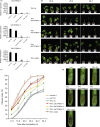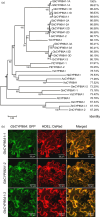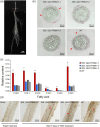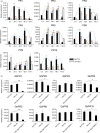GbCYP86A1-1 from Gossypium barbadense positively regulates defence against Verticillium dahliae by cell wall modification and activation of immune pathways
- PMID: 31207065
- PMCID: PMC6920168
- DOI: 10.1111/pbi.13190
GbCYP86A1-1 from Gossypium barbadense positively regulates defence against Verticillium dahliae by cell wall modification and activation of immune pathways
Abstract
Suberin acts as stress-induced antipathogen barrier in the root cell wall. CYP86A1 encodes cytochrome P450 fatty acid ω-hydroxylase, which has been reported to be a key enzyme for suberin biosynthesis; however, its role in resistance to fungi and the mechanisms related to immune responses remain unknown. Here, we identified a disease resistance-related gene, GbCYP86A1-1, from Gossypium barbadense cv. Hai7124. There were three homologs of GbCYP86A1 in cotton, which are specifically expressed in roots and induced by Verticillium dahliae. Among them, GbCYP86A1-1 contributed the most significantly to resistance. Silencing of GbCYP86A1-1 in Hai7124 resulted in severely compromised resistance to V. dahliae, while heterologous overexpression of GbCYP86A1-1 in Arabidopsis improved tolerance. Tissue sections showed that the roots of GbCYP86A1-1 transgenic Arabidopsis had more suberin accumulation and significantly higher C16-C18 fatty acid content than control. Transcriptome analysis revealed that overexpression of GbCYP86A1-1 not only affected lipid biosynthesis in roots, but also activated the disease-resistant immune pathway; genes encoding the receptor-like kinases (RLKs), receptor-like proteins (RLPs), hormone-related transcription factors, and pathogenesis-related protein genes (PRs) were more highly expressed in the GbCYP86A1-1 transgenic line than control. Furthermore, we found that when comparing V. dahliae -inoculated and noninoculated plants, few differential genes related to disease immunity were detected in the GbCYP86A1-1 transgenic line; however, a large number of resistance genes were activated in the control. This study highlights the role of GbCYP86A1-1 in the defence against fungi and its underlying molecular immune mechanisms in this process.
Keywords: GbCYP86A1-1; Gossypium barbadense; Verticillium dahliae; cell wall modification; cytochrome P450 fatty acid ω-hydroxylase; immune pathway.
© 2019 The Authors. Plant Biotechnology Journal published by Society for Experimental Biology and The Association of Applied Biologists and John Wiley & Sons Ltd.
Conflict of interest statement
The authors declared that they had no competing interests.
Figures








Similar articles
-
GbSOBIR1 confers Verticillium wilt resistance by phosphorylating the transcriptional factor GbbHLH171 in Gossypium barbadense.Plant Biotechnol J. 2019 Jan;17(1):152-163. doi: 10.1111/pbi.12954. Epub 2018 Jul 24. Plant Biotechnol J. 2019. PMID: 29797390 Free PMC article.
-
Transcriptome profiling of Gossypium barbadense inoculated with Verticillium dahliae provides a resource for cotton improvement.BMC Genomics. 2013 Sep 22;14:637. doi: 10.1186/1471-2164-14-637. BMC Genomics. 2013. PMID: 24053558 Free PMC article.
-
Overexpression of 3-deoxy-7-phosphoheptulonate synthase gene from Gossypium hirsutum enhances Arabidopsis resistance to Verticillium wilt.Plant Cell Rep. 2015 Aug;34(8):1429-41. doi: 10.1007/s00299-015-1798-5. Epub 2015 May 1. Plant Cell Rep. 2015. PMID: 25929795
-
Insights to Gossypium defense response against Verticillium dahliae: the Cotton Cancer.Funct Integr Genomics. 2023 May 1;23(2):142. doi: 10.1007/s10142-023-01065-5. Funct Integr Genomics. 2023. PMID: 37121989 Review.
-
An Overview of the Molecular Genetics of Plant Resistance to the Verticillium Wilt Pathogen Verticillium dahliae.Int J Mol Sci. 2020 Feb 7;21(3):1120. doi: 10.3390/ijms21031120. Int J Mol Sci. 2020. PMID: 32046212 Free PMC article. Review.
Cited by
-
Phylogenomic analysis of cytochrome P450 multigene family and its differential expression analysis in pepper (Capsicum annuum L.).Front Plant Sci. 2022 Dec 6;13:1078377. doi: 10.3389/fpls.2022.1078377. eCollection 2022. Front Plant Sci. 2022. PMID: 36561456 Free PMC article.
-
Hub Gene Mining and Co-Expression Network Construction of Low-Temperature Response in Maize of Seedling by WGCNA.Genes (Basel). 2023 Aug 7;14(8):1598. doi: 10.3390/genes14081598. Genes (Basel). 2023. PMID: 37628649 Free PMC article.
-
Genome‑wide identification of the cotton FAR gene family reveals GhFAR3 as a positive regulator of Verticillium dahliae resistance.BMC Plant Biol. 2025 Jul 7;25(1):887. doi: 10.1186/s12870-025-06908-w. BMC Plant Biol. 2025. PMID: 40624479 Free PMC article.
-
Identification of Key Genes during Ethylene-Induced Adventitious Root Development in Cucumber (Cucumis sativus L.).Int J Mol Sci. 2022 Oct 26;23(21):12981. doi: 10.3390/ijms232112981. Int J Mol Sci. 2022. PMID: 36361778 Free PMC article.
-
The mechanism of sesame resistance against Macrophomina phaseolina was revealed via a comparison of transcriptomes of resistant and susceptible sesame genotypes.BMC Plant Biol. 2021 Mar 29;21(1):159. doi: 10.1186/s12870-021-02927-5. BMC Plant Biol. 2021. PMID: 33781203 Free PMC article.
References
-
- Álvarez, K. and Vasquez, G. (2017) Damage‐associated molecular patterns and their role as initiators of inflammatory and auto‐immune signals in systemic lupus erythematosus. Int. Rev. Immunol. 36, 259–270. - PubMed
-
- Andersen, T.G. , Barberon, M. and Geldner, N. (2011) Suberization ‐ the second life of an endodermal cell. Curr. Opin. Plant Biol. 28, 9–15. - PubMed
-
- Bacete, L. , Mélida, H. , Miedes, E. and Molina, A. (2018) Plant cell wall‐mediated immunity: Cell wall changes trigger disease resistance responses. Plant J. 93, 614–636. - PubMed
-
- Beisson, F. , Li‐Beisson, Y. and Pollard, M. (2012) Solving the puzzles of cutin and suberin polymer biosynthesis. Curr. Opin. Plant Biol. 15, 329–337. - PubMed
Publication types
MeSH terms
Substances
LinkOut - more resources
Full Text Sources

